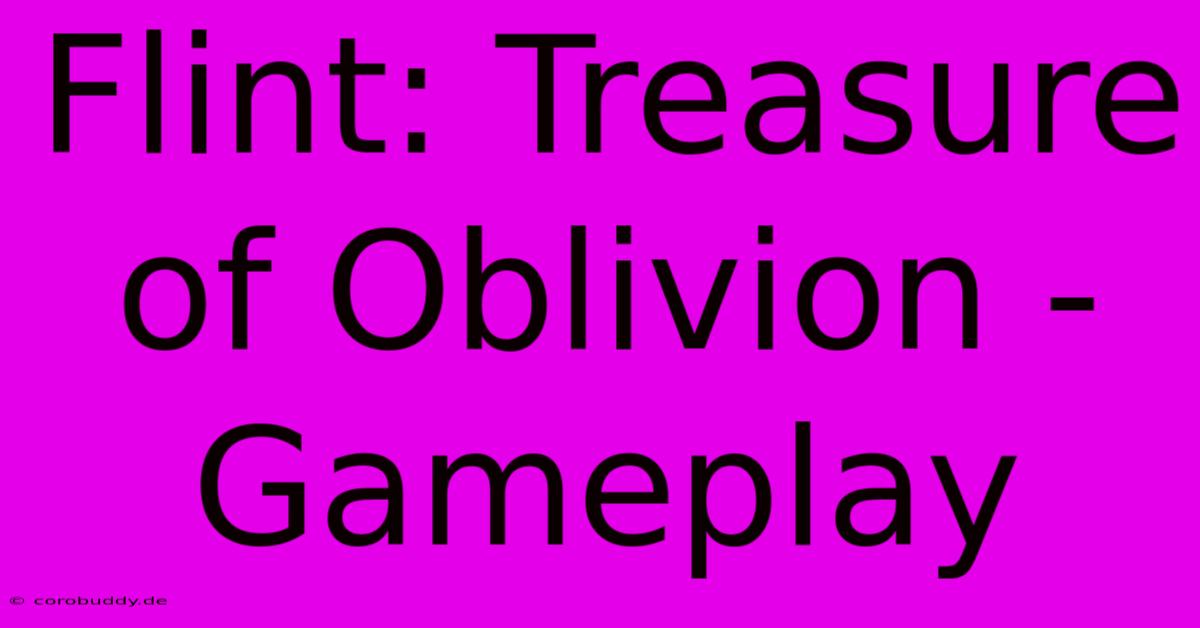Flint: Treasure Of Oblivion - Gameplay

Discover more detailed and exciting information on our website. Click the link below to start your adventure: Visit Best Website Flint: Treasure Of Oblivion - Gameplay. Don't miss out!
Table of Contents
Flint: Treasure of Oblivion - Gameplay: A Deep Dive into Pirate Adventure
Hey everyone! So, you're curious about Flint: Treasure of Oblivion's gameplay? Awesome! Let me tell you, I spent way too much time playing this game, and I've got some thoughts – both good and bad – to share. Think of this as a friend casually chatting about their favorite (and sometimes frustrating) pirate adventure.
Sailing the Seas and Swashbuckling: The Core Mechanics
Right off the bat, the sailing mechanics are pretty smooth. I mean, it's not totally realistic – we're talking about a video game, not a simulator – but it feels good. You've got your wind direction to consider, and you gotta time your turns, especially during those intense naval battles. It's not overly complicated, thankfully, which is perfect for someone like me who isn't a sailing expert. I remember one time, I was totally cocky, sailing straight into a storm, I almost lost my ship! Lesson learned: always check the weather forecast before setting sail.
Combat: Swords, Cannons, and Strategy
The combat is where things get really interesting. You've got your sword fighting, which is pretty straightforward – block, parry, attack. Pretty standard stuff, you know? But then there are the cannons! Positioning your ship correctly during a naval battle is key for success. I totally messed this up at first. I was like, "Cannonballs everywhere!", and I just ended up blasting the water. It took a few tries to understand the angle and range.
Pro Tip: Learn to use the environment to your advantage. Obstacles, rocks, even other ships can be used as cover or to create openings for your attacks. Trust me, it's a game changer.
Exploring Islands and Uncovering Secrets: More Than Just Fighting
But Flint isn't just about swashbuckling and naval battles. Exploration is a huge part of the experience. Each island you visit is packed with secrets, hidden treasures, and unique challenges. You'll be rummaging through caves, solving puzzles, and battling all sorts of enemies – from skeletons to giant crabs! It's the variety that keeps the gameplay fresh. The level design is pretty cool too. They don't just throw random stuff around; it feels purposeful and well thought-out.
One time, I spent like an hour searching for a hidden chest on a small island. I was so frustrated, thinking there was some crazy complicated puzzle I missed. Turned out it was just behind a cleverly placed rock. Sometimes the simplest solutions are the hardest to find, right?
The Quest System and its Rewards
The quest system is pretty standard. You get a quest, you go complete the quest, and you get rewards! Treasure, resources, experience—you name it! I'll tell you, though: some quests are way more challenging than others. I remember spending hours trying to figure out one riddle… It involved some seriously obscure historical references, and I almost gave up. But that feeling of finally solving it? Pure bliss. Totally worth the headache.
Overall Gameplay Experience: Worth Your Time?
Ultimately, Flint: Treasure of Oblivion offers a compelling mix of sailing, combat, and exploration. It’s got its flaws (the map could be a bit clearer, in my opinion), but the overall experience is enjoyable. If you're a fan of pirate games, or just looking for a fun adventure, I'd totally recommend checking it out. It's certainly not perfect, but the gameplay loop keeps you coming back for more!
Don't forget: This isn't just a game about mindless combat. Pay attention to detail, explore thoroughly, and don't be afraid to experiment. You might just uncover some hidden gems (pun intended!).

Thank you for visiting our website wich cover about Flint: Treasure Of Oblivion - Gameplay. We hope the information provided has been useful to you. Feel free to contact us if you have any questions or need further assistance. See you next time and dont miss to bookmark.
Featured Posts
-
Biden Macron Waffenruhe Gespraeche Libanon
Nov 24, 2024
-
Kunst Eklat Goldins Rede Die Reaktionen
Nov 24, 2024
-
Leganes Real Madrid Tv Uebertragung
Nov 24, 2024
-
Gaza Krieg Goldins Rede And Ausstellung
Nov 24, 2024
-
Gaza Krieg Goldins Neue Ausstellung
Nov 24, 2024
